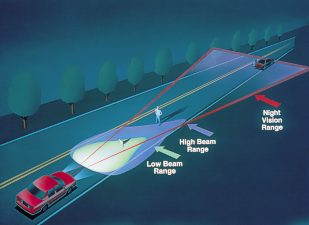

TechnoFILE is copyright and a registered trademark © ® of
Pandemonium Productions.
All rights reserved.
E-mail us Here!

Cadillac Offers Drivers New VisionOptional Display Cuts Through NightBy Jim Bray General Motors’ Cadillac division is blazing a trail through the darkest night with its “Night Vision” option. Currently offered as a $1995 enhancement to the DeVille, the technology is an offshoot of the gadgets the US military used during the Gulf War to help it carry out night missions against Saddam Hussein. Nighttime driving, according to the National Highway Traffic Safety Administration, only accounts for about twenty-five per cent of total driving. Despite this, it’s also when more than half of all traffic fatalities happen, so putting Night Vision on the highways and byways is a wonderful and long overdue move that could be a real life saver. GM says that, depending on the road conditions, Night Vision lets you see up to five times farther ahead than with your low beams. No figure was given for comparing it with high beams, unfortunately, but a lot of urban driving is done on low beam anyway, so Night Vision could be a lifesaver – literally – for those scary times when kids run out from between parked cars at night. Night Vision is also supposed to let you see through the glare of oncoming headlights. The feature uses infrared or “thermal imaging” technology (which senses heat emanating from an object) originally developed by Raytheon Systems Company. Human beings, animals and moving vehicles (whose engines are warm) stand out prominently in the display, thanks to their “high thermal contrast” compared to objects in the background. The “virtual image” that’s projected onto the Head’s Up Display (“HUD”) looks similar to a black and white photographic negative, with hotter objects appearing white with cooler objects in black. The HUD, which appears as if projected onto an area near the front of the car’s hood, is a great idea because – rather than having the image appear on a screen on the dashboard, for example – drivers don’t have to take their eyes off the road. In fact, the display supposedly stays in your peripheral vision and can be glanced at without having to refocus your eyes from their view of the road ahead. And that’s good. The system can be set to activate at the turning of the ignition key, when the Caddie’s “Twilight Sentinel photo cell” senses that it's dark outside, or when the headlights are turned on. Drivers can further control it – and adjust the intensity and vertical position of the Head’s Up Display’s image – with a switch on the instrument panel. As the system warms up, you see a Night Vision logo in the HUD (which lets you know it’s working). The logo remains on the screen until the gadget’s ready to rumble, whereupon it’s replaced by that “black and white negative” thermal image. Being able to see what’s on the road ahead of you at night has obvious advantages, but Night Vision can also be useful beyond the road ahead. Sure, you can make out potential dangers outside the range of your headlights on the Interstate but, closer to home, the thermal imaging could also let you see someone hiding in your bushes as you turn into your driveway. This could give you advance warning of a potentially dangerous situation on the home front; if you have a cellular phone, you could alert the police before getting out of the relative safety of your car. It’s such a terrific idea that it was named by Popular Science magazine as Grand Winner in the automotive category of the magazine’s yearly “Best of What’s New” list. I haven’t seen the system in action yet, but in the grand scheme of things it makes a lot of sense. The display doesn’t even have to be particularly realistic: as long as you can see that there’s something unusual of which you should be aware, the rest is gravy. It could also be a boon to peeping Toms… Night Vision isn’t meant to replace your keen eye on the road. It won’t turn a lousy driver into Michael Andretti, either, but the more help one has the better. Surprisingly, GM isn’t planning to offer Night Vision on any 2001 models other than the Cadillac DeVille but, if popular, it should only be a matter of time before it “trickles down” to other models. It’s a technology whose time has come and I hope it becomes an industry standard before long. Jim Bray is a member of the Automobile Journalists Association of Canada. His columns are available through the TechnoFile Syndicate. |
Support TechnoFile via Paypal |
TechnoFILE's
E-letter We're pleased to offer our FREE private, subscription-based private E-mail service. It's the "no brainer" way to keep informed. Our Privacy Policy |